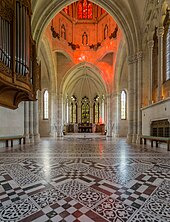
Cardiff Castle is a medieval castle and Victorian Gothic revival mansion located in the city centre of Cardiff, Wales. The original motte and bailey castle was built in the late 11th century by Norman invaders on top of a 3rd-century Roman fort. The castle was commissioned either by William the Conqueror or by Robert Fitzhamon, and formed the heart of the medieval town of Cardiff and the Marcher Lord territory of Glamorgan. In the 12th century the castle began to be rebuilt in stone, probably by Robert of Gloucester, with a shell keep and substantial defensive walls being erected. Further work was conducted by the 6th Earl of Gloucester in the second half of the 13th century. Cardiff Castle was repeatedly involved in the conflicts between the Anglo-Normans and the Welsh, being attacked several times in the 12th century, and stormed in 1404 during the revolt of Owain Glyndŵr.

Marquess of the County of Bute, shortened in general usage to Marquess of Bute, is a title in the Peerage of Great Britain. It was created in 1796 for John Stuart, 4th Earl of Bute.

Earl of Dumfries is a title in the Peerage of Scotland. It was originally created for William Crichton, 9th Lord Crichton of Sanquhar, in 1633, and stayed in the Crichton family until the death of the fourth countess in 1742, at which point the title passed to first the Dalrymple and then the MacDouall families before finally being inherited by the Marquesses of Bute, where it remains today.

John Patrick Crichton-Stuart, 3rd Marquess of Bute, was a Scottish landed aristocrat, industrial magnate, antiquarian, scholar, philanthropist, and architectural patron.

Castell Coch is a 19th-century Gothic Revival castle built above the village of Tongwynlais in South Wales. The first castle on the site was built by the Normans after 1081 to protect the newly conquered town of Cardiff and control the route along the Taff Gorge. Abandoned shortly afterwards, the castle's earth motte was reused by Gilbert de Clare as the basis for a new stone fortification, which he built between 1267 and 1277 to control his freshly annexed Welsh lands. This castle may have been destroyed in the native Welsh rebellion of 1314. In 1760, the castle ruins were acquired by John Stuart, 3rd Earl of Bute, as part of a marriage settlement that brought the family vast estates in South Wales.

Knightshayes Court is a Victorian country house near Tiverton, Devon, England, designed by William Burges for the Heathcoat-Amory family. Nikolaus Pevsner describes it as "an eloquent expression of High Victorian ideals in a country house of moderate size." The house is Grade I listed. The gardens are Grade II* listed in the National Register of Historic Parks and Gardens.

William Burges was an English architect and designer. Among the greatest of the Victorian art-architects, he sought in his work to escape from both nineteenth-century industrialisation and the Neoclassical architectural style and re-establish the architectural and social values of a utopian medieval England. Burges stands within the tradition of the Gothic Revival, his works echoing those of the Pre-Raphaelites and heralding those of the Arts and Crafts movement.

The Tower House, 29 Melbury Road, is a late-Victorian townhouse in the Holland Park district of Kensington and Chelsea, London, built by the architect and designer William Burges as his home. Designed between 1875 and 1881, in the French Gothic Revival style, it was described by the architectural historian J. Mordaunt Crook as "the most complete example of a medieval secular interior produced by the Gothic Revival, and the last". The house is built of red brick, with Bath stone dressings and green roof slates from Cumbria, and has a distinctive cylindrical tower and conical roof. The ground floor contains a drawing room, a dining room and a library, while the first floor has two bedrooms and an armoury. Its exterior and the interior echo elements of Burges's earlier work, particularly Park House in Cardiff and Castell Coch. It was designated a Grade I listed building in 1949.

Dumfries House is a Palladian country house in Ayrshire, Scotland. It is located within a large estate, around two miles (3 km) west of Cumnock. Noted for being one of the few such houses with much of its original 18th-century furniture still present, including specially commissioned Thomas Chippendale pieces, the house and estate is now owned by The Prince's Foundation, a charity which maintains it as a visitor attraction and hospitality and wedding venue. Both the house and the gardens are listed as significant aspects of Scottish heritage.

The Animal Wall is a sculptured wall depicting 15 animals in the Castle Quarter of the city centre of Cardiff, Wales. It stands to the west of the entrance to Cardiff Castle, having been moved from its original position in front of the castle in the early 1930s. The design for the wall was conceived by William Burges, architect to the third Marquess of Bute, during Burges's reconstruction of the castle in the 1860s, but it was not executed until the late 1880s/early 1890s. This work, which included the original nine animal sculptures, all undertaken by Burges's favourite sculptor, Thomas Nicholls, was carried out under the direction of William Frame, who had previously assisted Burges at both Cardiff Castle and Castell Coch. When the wall was moved in the early 20th century, the fourth Marquess commissioned Alexander Carrick to carve a further six sculptures to sit on the extended wall which now fronted Bute Park. The Animal Wall is a Grade I listed structure.

Clan Stuart of Bute is a Highland Scottish Clan and is a branch of the larger Clan Stewart.

Architecture in Cardiff, the capital city of Wales, dates from Norman times to the present day. Its urban fabric is largely Victorian and later, reflecting Cardiff's rise to prosperity as a major coal port in the 19th century. No single building style is associated with Cardiff, but the city centre retains several 19th and early 20th century shopping arcades.

Thomas Nicholls was an English sculptor.
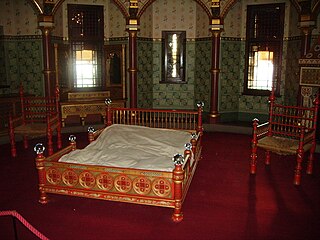
John Starling Chapple (1840–1922) was a stonemason and architect who worked as office manager for William Burges.
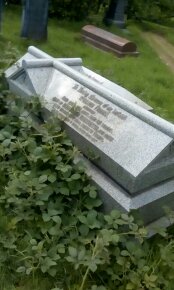
William Frame was an English architect.
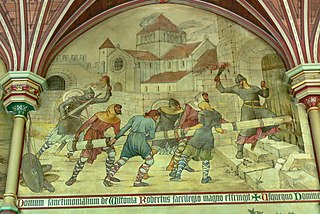
Horatio Walter Lonsdale (1844-1919) was an English painter and designer.
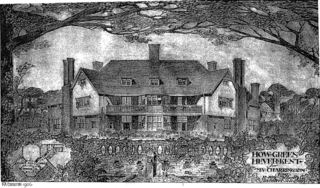
Robert Weir Schultz, later Robert Weir Schultz Weir and known as R. W. S. Weir, was a Scottish Arts and Crafts architect, artist, landscape designer and furniture designer. He did much work on the Isle of Bute. Almost all of his buildings are now category A listed buildings, reflecting the high quality of his work.

The Red Bed is a piece of painted furniture designed by the English architect and designer William Burges made between 1865 and 1867. Built of mahogany, painted blood red and decorated with imagery of the Sleeping Beauty fairy tale, it was made for Burges's rooms at Buckingham Street, and later moved to his bedroom at The Tower House, the home he designed for himself in Holland Park. Burges wanted to fill his home with furniture decorated with paintings; they served not only their obvious practical purposes, “but spoke and told a story”. After catching a chill while engaged on works for the Marquess of Bute at Cardiff, Burges returned to the Tower House and died in the Red Bed, aged 53, on 20 April 1881.

From 1865 until his death in 1881 the Victorian architect William Burges undertook the reconstruction of Cardiff Castle for his patron, John Crichton-Stuart, 3rd Marquess of Bute. The rebuilding saw the creation of some of the most significant Victorian interiors in Britain.
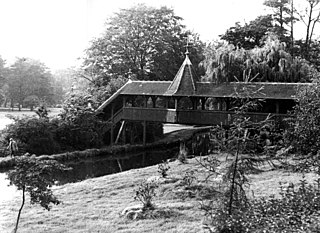
The Swiss Bridge at Cardiff Castle was built by the architect William Burges for John Crichton-Stuart, 3rd Marquess of Bute in 1873. Modelled on the Kapellbrücke in the Swiss city of Lucerne, it provided a link from the castle into Bute's private gardens which now form Bute Park. By the 1960s, the bridge had become dilapidated and it was demolished in 1963.



